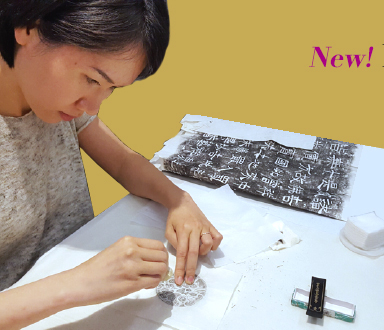For over 1,500 years, ink rubbing has been a vital medium for the preservation of Chinese art, culture, and history. Compared to photography, rubbings provide sharper and more convincing images by accurately documenting every detail of the inscription or pictorial design. After the loss or the deterioration of many original objects through centuries, ink rubbings became the sole remaining evidence of a significant number of China’s artistic and cultural heritages.
Apply sheets of paper onto the surface of the object, then carefully ink the surface to create an image – this is how ink rubbings are made for any hard material, including stone steles, cliffside engravings, bronze vessels, jade carvings, or even oracle bones and figurines. Nowadays, pioneer artists such as Xu Bing and Qiu Zhijie also favor for this unique style of art.
In the first part of the three-session workshop, students will obtain an overall understanding of ink rubbing in the cultural context, its history, different schools, and the techniques of making rubbings. Students will learn to use the traditional tools, and make use of the new tools and techniques developed by the instructor. In the second session, students will get to understand different techniques required for various materials. They will practice the variety of artistic renderings in ink rubbing, such as the ‘cicada-wing rubbing’ and ‘black-gold rubbing’. In the last session, students will also have the chance to learn the advanced technique of three-dimensional rubbing quanxing ta, or “rubbing of a complete shape”. By the end of the workshop, students will be able to make ink rubbings independently, acquire the connoisseurship of ink rubbing, and deepen their understandings of Chinese classical art and culture.
About the Instructor
Li Zhi is a disciple of the ink rubbing Master Xie Haiyuan of the Shanghai Museum, and has studied extensively with various ink rubbing experts in China. After gaining a Master’s Degree in Fine Arts and moving to New York in 2009, Li Zhi has created numerous works for art institutions such as The Metropolitan Museum of Art and the Christie’s Auction House, as well as important private collectors. In 2014, invited by Christie’s, Li Zhi made rubbings for the ‘Min’ Fanglei, a ritual bronze vessel ranked amongst the most expensive Chinese archaic bronzes sold at auction, which was subsequently acquired by the Hunan Provincial Museum. In March of 2017, she created rubbings for the Fujita Fanglei. Li Zhi is passionate about revitalizing the ancient technique by making rubbings for modern objects. She believes that the process of ink rubbing is a meditative way of appreciating and connecting with the craftsmanship in the past and present.
